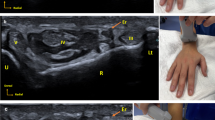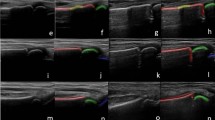Abstract
Objective
To assess the ability of a newly developed AI-powered ultrasound 3D hand scanner to visualize joint structures in healthy hands and detect degenerative changes in cadaveric hands.
Materials and Methods
Twelve individuals (6 males, 6 females, age 43.5 ± 17.8 years) underwent four scans with the 3D ultrasound tomograph (right and left hand, dorsal and palmar, respectively) as well as four sets of handheld ultrasound of predefined anatomic regions. The 3D ultrasound tomographic images and the standard handheld ultrasound images were assessed by two radiologists with regard to visibility of bone contour, joint capsule and space, and tendons. In addition, three cadaveric hands were scanned with the 3D ultrasound tomograph and CT.
Results
Mean scan time for both hands was significantly faster with handheld ultrasound (10 min 30 s ± 95 s) compared to 3D ultrasound tomography (32 min 9 s ± 6 s; p < 0.001). Interreader and intermodality agreement was moderate (0.4 < κ ≤ 0.6) to substantial (0.6 < κ ≤ 0.8). Overall visibility of joint structures was comparable between the modalities at the level of the wrist (p = 0.408), and significantly better with handheld ultrasound at the level of the finger joints and the thumb (both p < 0.001). The 3D ultrasound tomograph was able to detect osteophytes in cadaveric hands which were confirmed by CT.
Conclusion
The AI-powered 3D ultrasound tomograph was able to visualize joint structures in healthy hands and singular osteophytes in cadaveric hands. Further technical improvements are necessary to shorten scan times and improve automated scanning of the finger joints and the thumb.





Similar content being viewed by others
References
Szkudlarek M, Court-Payen M, Strandberg C, Klarlund M, Klausen T, Ostergaard M. Power Doppler ultrasonography for assessment of synovitis in the metacarpophalangeal joints of patients with rheumatoid arthritis: a comparison with dynamic magnetic resonance imaging. Arthritis Rheum. 2001;44(9):2018–23.
D’Agostino MA, Terslev L, Aegerter P, et al. Scoring ultrasound synovitis in rheumatoid arthritis: a EULAR-OMERACT ultrasound taskforce–part 1: definition and development of a standardized, consensus-based scoring system. RMD Open. 2017;3(1):e000428.
Terslev L, Naredo E, Aegerter P, et al. Scoring ultrasound synovitis in rheumatoid arthritis: a EULAR-OMERACT ultrasound taskforce-part 2: reliability and application to multiple joints of a standardized consensus-based scoring system. RMD Open. 2017;3(1):e000427.
Husic R, Lackner A, Stradner MH, Hermann J, Dejaco C. Joint positions matter for ultrasound examination of RA patients–increased power Doppler signal in neutral versus flat position of hands. Rheumatology (Oxford). 2017;56(8):1312–9.
Di Matteo A, Kulveer M, Azukizawa M, Wakefield RJ. The role of musculoskeletal ultrasound in the rheumatoid arthritis continuum. Curr Rheumatol Rep. 2020;22(8):41.
Do Prado AD, Staub HL, Bisi MC, et al. Ultrasound and its clinical use in rheumatoid arthritis: where do we stand? Adv Rheumatol. 2018;58(1):19.
Ronneberger O, Fischer P, Brox T. U-Net: Convolutional Networks for Biomedical Image Segmentation. In: Navab N, Hornegger J, Wells W, Frangi A, editors. Medical image computing and computer-assisted intervention–MICCAI 2015. MICCAI 2015. Lecture Notes in Computer Science, vol. 9351. Cham: Springer; 2015. p. 234–41.
Janta I, Valor L, De la Torre I, et al. Ultrasound-detected activity in rheumatoid arthritis on methotrexate therapy: which joints and tendons should be assessed to predict unstable remission? Rheumatol Int. 2016;36(3):387–96.
Likert R. A technique for the measurements of attitudes. Archives of Psychology. 1932;140:5–55.
Landis JR, Koch GG. The measurement of observer agreement for categorical data. Biometrics. 1977;33(1):159–74.
Girometti R, Zanotel M, Londero V, Bazzocchi M, Zuiani C. Comparison between automated breast volume scanner (ABVS) versus hand-held ultrasound as a second look procedure after magnetic resonance imaging. Eur Radiol. 2017;27(9):3767–75.
Su J, Han X, Yang F, Song Y, Lei H, Wang X, Fan X, Li Y. Application of automated hand ultrasound scanning and a simplified three-joint scoring system for assessment of rheumatoid arthritis activity. Ultrasound Med Biol. 2021;47(10):2860–8.
Backhaus M, Ohrndorf S, Kellner H, et al. Evaluation of a novel 7-joint ultrasound score in daily rheumatologic practice: a pilot project. Arthritis Rheum. 2009;61(9):1194–201.
Hammer HB, Sveinsson M, Kongtorp AK, Kvien TK. A 78-joints ultrasonographic assessment is associated with clinical assessments and is highly responsive to improvement in a longitudinal study of patients with rheumatoid arthritis starting adalimumab treatment. Ann Rheum Dis. 2010;69(7):1349–51.
Naredo E, Rodríguez M, Campos C, et al. Validity, reproducibility, and responsiveness of a twelve-joint simplified power Doppler ultrasonographic assessment of joint inflammation in rheumatoid arthritis. Arthritis Rheum. 2008;59(4):515–22.
Elangovan S, Tan YK. The role of musculoskeletal ultrasound imaging in rheumatoid arthritis. Ultrasound Med Biol. 2020;46(8):1841–53.
Funding
This research was partially funded by the Early Career Grant awarded by the International Skeletal Society.
Author information
Authors and Affiliations
Corresponding author
Ethics declarations
Ethics approval
All procedures performed in studies involving human participants were in accordance with the ethical standards of the institutional and/or national research committee and with the 1964 Helsinki declaration and its later amendments or comparable ethical standards.
Conflict of interest
S.B. is a co-founder of Aison Technologies AG, provided the 3D ultrasound tomography prototype, participated in data acquisition, and performed image post-processing. She was not involved in data analysis or interpretation. R.G. is a scientific advisor of Aison Technologies AG. The other authors declare that they have no conflict of interest.
Additional information
Publisher's note
Springer Nature remains neutral with regard to jurisdictional claims in published maps and institutional affiliations.
Rights and permissions
About this article
Cite this article
Getzmann, J.M., Kaniewska, M., Rothenfluh, E. et al. Comparison of AI-powered 3D automated ultrasound tomography with standard handheld ultrasound for the visualization of the hands—clinical proof of concept. Skeletal Radiol 51, 1415–1423 (2022). https://doi.org/10.1007/s00256-021-03984-5
Received:
Revised:
Accepted:
Published:
Issue Date:
DOI: https://doi.org/10.1007/s00256-021-03984-5




